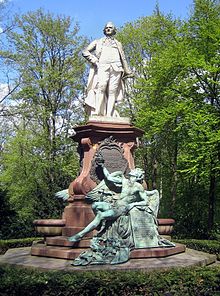


Otto Lessing (24 February 1846 – 22 November 1912) was a prominent German Historicist sculptor whose work largely shaped the appearance of Berlin in the late 19th and early 20th centuries. He was the son of history and landscape painter Carl Friedrich Lessing and the great great nephew of poet Gotthold Ephraim Lessing.[1][2]
Lessing created sculpture and decorative architectural elements on the façades and interiors of many important buildings in Germany, such as the Reichstag, Berlin Cathedral and the Reichsgericht (Supreme Court) in Leipzig. In addition to large public contracts, he also designed commercial buildings and residential villas. At the height of his career in 1911, Lessing was appointed to the Senate of the Prussian Academy of Arts[2] and awarded the Pour le Mérite in Science and Arts (German: Pour le mérite für Wissenschaft und Künste), Germany's highest civilian decoration.[3]
- ^ Bueckling, Maraike; Hüfler, Brigitte (2003). "Lessing family". Oxford Art Online. Oxford University Press. doi:10.1093/gao/9781884446054.article.t050610.
- ^ a b Jörg Kuhn: Otto Lessing 1846–1912 (Berlin: Freie Universität, 1994) Online summary Archived 8 August 2014 at the Wayback Machine (in German)
- ^ Pour le Mérite für Wissenschaft und Künste Official Website (in German) retrieved 29 February 2012.